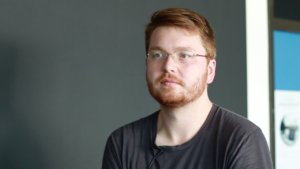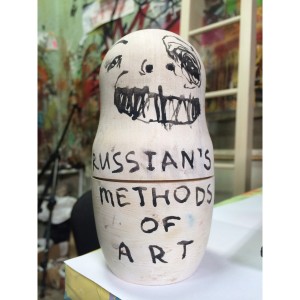Well, this is difficult because the artwork may be a process at one time, and another time it is a photograph and sometimes it is a video. And then video and photography are dissolved in favor of an installation and so on. That means, there is little that is established. Not too long ago, I had a very detailed discussion precisely about the question of form, so what form will it have in the end. And this discussion was accompanied in very critical way. Two people, who took some time, had a look at the artworks, people with whom I had been in contact with for quite some time, and it was important to me that they gave some feedback. And it was quite interesting to note that they understood this energy, that they understood this process I go into, and one has to stick to it and be reliable and put a lot of energy into it. So, I do not live in the area where the earthquake was. I fly out again and I will come back and what will I bring with me? And the first thing I bring with me is of course this energy, that there is a process getting started, that there is a project getting started. This has already a format. Clearly. That would be in my understanding already now an artwork. This energy is already an artwork. This process is already an artwork. But because I worked in a more participative way in this project, I naturally asked myself if the conditions that constituted it… for example, that there is a cameraman who films it and that it will be transcribed and that all the texts will be read again. Therefore the artwork is extremely complex at „New Pott“. That is why the idea was always to have a fix place where the artwork is exhibited permanently and where one has access to the archive because the archive is of course more extensive than what can be shown in an exhibition and we are close to being able to implement that. So the basis is scientific material on the question that was politically intensified by the debate of Thilo Sarrazin in the years 2009 to 2014 for example. The topic of how migration works: how do people enter countries or how do they leave the original country? Is it an escape, is it connected to violence? Is this connected to restriction? Or economic impacts, educational consequences or very personal traumas. And I have collected this and made it a subject of my discussion together with the social scientist, Harald Welzer, who was involved in the work process. He looked at it and commented it in meta texts and then we asked Christoph Keller, the former publisher of Revolver to bring the whole thing into a creative form. And so one realises that when we are talking about an artwork, we have already at least three authors, plus one hundred families and in total almost 500 people who are involved in such a process and this is of course an incredible amount of communication. During that time we have been two more people here in the studio that have entirely kept in contact with the families. For three years. This is an incredible effort but of course you get to know the people. One can connect the stories to the faces and the faces to the stories, furthermore their personal habitats and their livelong dreams. So it is totally complex. It is difficult to apply the concept of the artwork in this case. There are also other situations. In Platon, for example, it has been relatively clear. There are suddenly these four rooms. Of course, they were also generated, this did not happen in one day, but there are just 4 rooms, then there is a series of photographs, then there is a series of video installations and after a certain time, so while walking, so in the movement, I notice: This is the thing that is suddenly connected with it and this is a complex of an artwork. In my life I would spent less time to ask me: How I am perceived as an artist? What is my definition of an artwork? I prefer to stick to the edges – where can art production still be relevant to society? And how is the effect and whether it is understood as an artwork, or as a multiple authorship, and all these terms … It is good to know and to have these terms, but they are not really central and constitutive for what is interesting to me.
Ja, das ist schwierig weil das Werk mal ein Prozess ist, mal ist es eine Fotografie und mal ist es aber auch ein Video. Und dann werden Video und Fotografie wieder aufgelöst zugunsten einer Installation und so weiter. Will sagen, es gibt wenig Festgeschriebenes. Und ich habe gerade, vor nicht all zu langer Zeit, eine sehr ausführliche Diskussion genau über die Frage der Form, also welche Form hat das dann am Ende, geführt. Und diese Diskussion wurde sehr kritisch begleitet. Da haben sich zwei Leute Zeit genommen und haben sich die Arbeiten angeguckt, mit denen ich auch schon länger im Gespräch bin und mir war das wichtig, dass die mir eher Feedback geben. Und das war ganz interessant, dass relativ schnell klar wurde, dass sie diese Energie verstehen, dass sie diesen Prozess verstehen, auf den ich da eingehe und da muss man auch dran bleiben und zuverlässig sein und mit sehr, sehr viel Kraft da rein gehen. Also ich lebe nicht in der Zone, wo das Erdbeben war. Ich fliege wieder raus und ich komme dann wieder und was bringe ich dann mit? Und das erste, was ich dann mitbringe ist natürlich diese Energie, dass da ein Prozess in Gang kommt, dass da ein Projekt in Gang kommt. Das hat schon ein Format. Ganz eindeutig. Das wäre ja jetzt nach meinem Verständnis auch schon Werk. Diese Energie ist schon Werk. Dieser Prozess ist schon Werk. Aber ich habe mich natürlich, weil ich ja bei dem Projekt wo ich stärker ins Partizipative reingegangen bin, habe ich mich natürlich auch gefragt, dass die ganzen Bedingungen, die das konstituieren, zum Beispiel, dass da ein Kameramann ist und das aufnimmt und dass das transkribiert wird und dass die Texte alle noch mal gelesen werden. Da ist das Werk bei „New Pott“ natürlich extrem komplex. Deswegen war ja immer die Idee und wir sind nah dran, dass das gelingt, dass das einen festen Ort hat, wo diese Arbeit dauerhaft zu sehen sein wird und wo man auf das Archiv zugreifen kann, weil das Archiv natürlich umfänglicher ist als das, was man in einer Ausstellung zeigen kann. Also das ist wissenschaftliches Ausgangsmaterial über die Frage wie in den Jahren 2009-2014, wo es ja auch politisch hochgekocht worden ist durch Thilo Sarrazins Debatte zum Beispiel. Wie so das Thema Migration funktioniert. Also wie reisen Menschen ein oder wie reisen sie aus dem ursprünglichen Land aus? Ist das Flucht, ist das mit Gewalt verbunden? Ist das mit Restriktionen verbunden? Oder wirtschaftlichen Folgen, Bildungsfolgen oder sehr persönlichen Traumata. Und das habe ich sozusagen erst mal eingesammelt und mit dem Sozialwissenschaftler, Harald Welzer, der mit an dem Werkprozess beteiligt war, thematisiert. Der hat sich das angeschaut und hat das mit Metatexten kommentiert und dann haben wir den Christoph Keller, der früher Verleger von Revolver war, gebeten das Ganze in eine gestalterische Form zu bringen. Und da merkt man schon, wenn wir jetzt hier von einem Werk sprechen, dann haben wir schon mindestens drei Autoren plus die hundert Familien und insgesamt dann fast 500 Personen, die an so einem Prozess dann beteiligt sind und das ist natürlich unglaublich viel an Kommunikation. Da waren wir auch hier im Atelier zwei Personen mehr, die ausschließlich nur den Kontakt zu den Familien gehalten haben. Und das über drei Jahre. Das ist ein unglaublicher Aufwand aber natürlich lernt man die Menschen kennen. Man hat zu den Gesichtern Geschichten und zu den Geschichten Gesichter und dazu deren persönliche Lebensräume und Lebensträume. Also es ist total komplex. Das ist schon schwierig den Werkbegriff da anzulegen. Es gibt aber auch andere Situationen. Bei „Platon“ zum Beispiel, ist das relativ klar gewesen. Da gibt es dann eben plötzliche diese vier Räume. Das ist natürlich auch nicht von einem auf den anderen Tag passiert aber es sind eben vier Räume, dann gibt es eine Serie von Fotografien, dann gibt es eine Serie von Videoinstallationen und nach einer gewissen Zeit, also im Gehen also in der Bewegung, stelle ich fest: Das ist das was plötzlich damit verbunden ist und das ist ein Werkkomplex. Ich würde in meinem Leben weniger Zeit darauf verwenden mich zu fragen: Wie werde ich als Künstler wahrgenommen? Wie sieht mein Werkbegriff aus? Mich also eher an den Rändern zu kümmern wo kann denn künstlerische Produktion denn überhaupt noch gesellschaftlich relevant Wirkung entfalten? Und wie diese Wirkung dann ist und ob das als Werk begriffen wird oder als multiple Autorenschaft und all diese Begrifflichkeiten…Es ist gut, dass man sie kennt und hat, sie sind aber für das was mich interessiert nicht so wirklich zentral und konstitutiv.

















